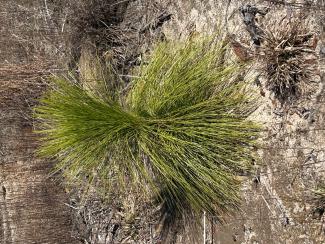Longleaf Pine Seedlings Make the Journey Home
Josef Orosz, Region 8/USDA FS-Savannah River/Public Affairs

If you ever made the journey back home to where you came from, you know it can be a memorable trip. Over the next few months, roughly 300,000 Longleaf pine seedlings will make that same trip back home to be planted where they came from, here on the Savannah River Site.
Almost every year, forest service employees collect Longleaf pinecones from select areas on SRS and send them to a nursery for seed extraction and storage. When foresters on Savannah River complete the planning cycle for the next planting season, they call the nursery to place a seedling order. The seeds are pulled from storage, planted, and grown into seedlings to start their journey home.
“Once the seedling is planted, it grows into a grass-like seedling stage. During this stage of slow growth, a robust taproot develops for drought resistance and nutrient storage. The seedling is resistant to fire damage during this stage,” said USDA Forest Service - Savannah River Silviculturist Eileen Eck. “After the seedling develops for 2-7 years in the ‘grass’ stage, the tree will enter the ‘rocket’ stage. This period of rapid growth allows the tree to quickly reach heights where needles are above flame lengths of surface fires.”
Not every Longleaf pine seedling will become a fully mature tree supplying the next generation of seeds. Several times over the next 40 years, timber crews will survey a pre-determined area, marking trees with forked trunks or other defects for removal. This process is called thinning. Removing these trees opens the forest canopy, allowing higher-quality pines to grow taller and fully mature. The remaining Longleaf pines will have superior growth qualities, and from these trees the next generation of seeds will be harvested.

Looking down at a grass stage Longleaf Pine seedling.
Keeping those trees healthy involves more than just thinning at periodic intervals; prescribed fire also plays a big part in keeping the forest healthy. The forest service uses these fires to reduce or eliminate hardwood growth and potentially hazardous wildfire fuels in areas where the Longleaf pine is growing. Reducing competition and hazardous fuels in these areas helps the young pine trees grow faster and healthier.
Longleaf pine at one time was the dominant tree species in the southeastern United States. The tree is the preferred habitat of the Red-cockaded woodpecker in part because of the large amount of resin exuded by the tree after the bird makes a cavity nest within it. The resin serves as a protective barrier surrounding the cavity as a defense against predators.
The active forest management efforts employed by the USDA Forest Service Savannah River consisting of planting seedlings every year, managing timber stands for tree health, providing habitat necessary for wildlife species survival, and eventually conducting high-value timber harvests, ensure the sustainability and productivity of forests on the Savannah River Site for many years to come.


